|
The development
It was the Renault FT light tank, first used in action in May 1918, and of which more than 3000 were produced before November, that really satisfied the belief in a new weapon. Above all, the Renault FT was a pioneer vehicle and gave application to many new ideas which were taken up later. In fact, the FT rightfully holds a highly prominent place in the history of the development of armoured vehicles, because it was radically different both in its internal layout and externally by having, for the first time, a 360ฐ revolving turret.
The Italian Army obtained very few FT tanks for carrying out tests; these were so encouraging that the Italian HQ decided to produce their own light tank, closely modelled on the French FT. Help was given to the Fiat company of Turin to start the design of the Fiat 3000 tank. Although the Fiat 3000 was developed from the FT, and retained the same basic shape and layout, it differed from the French tank and contained a number of original features. Much development work was carried out, and it was not until June 1919 that a prototype was ready. After some tests, marked by breakdowns, production started and the very first tank was completed in the summer of 1920, called Carro Armato modello 1921 (Tank, model 1921), 100 of which were produced until the end of 1928.
The basic
shape of the tank was a narrow armoured box, with no chassis. The armour
was 16 mm thick on the front and sides of hull and turrets, some other
areas varied between 6 and 8 mm. The engine was at the rear, separated
from the crew by a steel bulk-head and was started manually either inside
or outside the vehicle; access to the power plant was through panels
situated on the rear vehicle decking. The tracks passed over the large
diameter front idlers, which were projected well forward of the vehicle
for a better cross country ride and particularly to mount vertical obstacles
and climb in and out of shell holes and shattered trenches. The tracks
were tensioned against the adjustable idlers and the shoes were fitted
with prominent studs. The ground track run was supported by four sets
of rollers and the whole assembly was mounted on a heavy girder carried
on leaf springs. The upper track run was carried by a rail with five
small guide rollers, this rail was pivoted at its rear end and was tensioned
upwards against the track by a coil spring at the front end. A removable
"tail"was fitted on the rear of the vehicle to increase its effective
length for trench crossing. The driving and fighting compartment occupied
the front of the vehicle. It was accessible only the from turret, at
least on the Model 1921 version. The driver was positioned in the front
of the vehicle, his vision was provided by slots and an opening shutter.
The gunner-commander position was under the turret at the centre of
the vehicle, where he could occupy a standing or sitting position. The
commander anyway could perform neither role efficiently. The turret
made up of flat armoured plates similar to the early versions of the
FT was mounted on a bearing race and could be locked in position or
easily turn manually. In addition to the double escape doors at the
rear, the turret was surmounted by a "hat" shaped dome which could be
tilted open to ventilate the crew compartment. The circular rim on which
this dome was mounted had some vision slits and formed a simple cupola.
All armament of the tanks was concentrated in the turret, originally
built with enough room for twin machine guns (the air-cooled 6.5mm SIA
mod. 18). The ammunition was stored in the base of the turret and along
the walls of the fighting compartment.
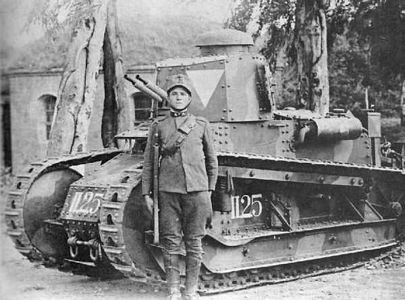
|
|
The original mod. 21 version
All the typical features can be seen, such as the main armament of twin SIA mod. 18 machine guns. |
_t.jpg)
| |
A FIAT 3000 mod. 21 during testing
The vehicle demonstrated some technical advantages over the FT-17, but the armament was immediately considered insufficient for post-WWI warfare.
|
During the 1927 field manoeuvres, it appeared clear that there was a need for a better armament rather than just a couple of machine guns. Accordingly, it was planned to mount in the turret a Vickers-Terni 37mm gun, at that time a match for any tank in Europe. But with a 125 kg weight of the gun, the Fiat 3000 became underpowered and with poor cross country performance without an improved engine. The Fiat Arsenal in Turin started to plan and design fundamental alterations like a more powerful engine and a reworked turret, and in 1928 the Italian military authorities ordered 52 tanks with the designation Carro Armato modello 1930 (Tank, model 1930). However, it was not possible to complete all vehicles with the 37 mm guns, because they were in very short supply, and at least 24 of them kept the same armament of the previous Model 1921. Again, the production rate was slow and only after February 1933 more tanks were ready. Externally, the model 1930 differed from the earlier model 1921 in some ways. Besides the bigger engine deck, other points of recognition were the larger idler wheel and, the most fundamental alteration, the new turret. Other novel features were the access for the driver by means of a new hatch in the glacis plate and a sloped skirt added to the hull sides, a protection from mud and debris accumulated on cross country duty.
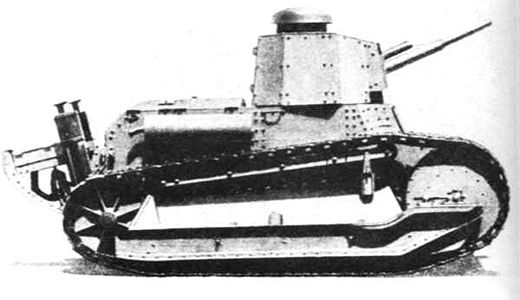
|
|
FIAT 3000 mod. 30 version
The mod. 30 was rather different from mod. 21, not only because the turret was different. However, only a small number of vehicles received the new turret. |
For some ten years, until 1935, the little Fiat tank became the main equipment of the Italian armoured units. In an effort to correct at least some faults, modifications were introduced both during production and retrospectively. Few other details changed: in 1935 the bottom frames of the suspensions were reinforced in four locations at every side. By the same time, the original armament of SIA machine guns was found unfit and from April 1936 the Fiat 14/35 machine gun was used on many of the early examples instead. The two weapons were mounted higher and had armoured jackets. The weapon had the same calibre as the infantry equipment and the CV tankettes, but remained cumbersome and prone to jams; in the same period, the 37mm guns were gradually dismounted from the vehicles carrying it because they were needed for the M11/39 tanks. This unsatisfactory armament soon turned out to be a poor choice for use on tanks and it was soon shown that only two machine guns on tanks in 1940 were inadequate.
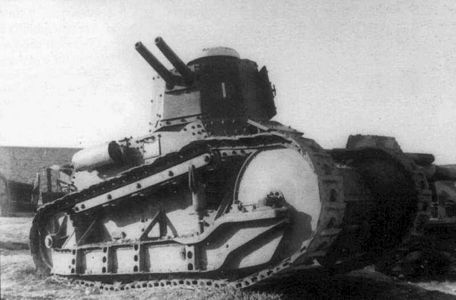
|
|
The FIAT 3000 mod. 30 with the 1935 modifications (final version)
The new mount for the FIAT 14/35 machine guns can be seen, along with the 4 box-shaped reinforcements on the suspensions (with holes). |
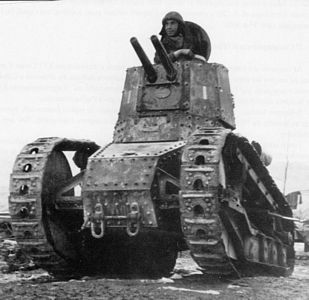
| |
The FIAT 3000 mod. 30 with the 1935 modifications (final version)
One of the few tanks of Frontier Guard in service on the Balkans Front, late 1940. (AUSSME).
|
|
|
Operational use
The first operational use of the tank was in 1926, when 2 two Fiat 3000 took part in the operations for the reconquest of the oasis of Giarabub, in Lybia, where the Italian dominion over the country was adversed by guerrilla warfare. The Italian military expedition departed on February 1, 1926, as a military column lead by Colonel Ronchetti, which comprised 36 armored vehicles (a squadron of Tripoli armoured cars, 8 armed trucks, a section of 2 Ford T armored cars) and 2 Fiat 3000. The tanks greatly slowed down the entire column; the results of their use was therefore not brilliant.
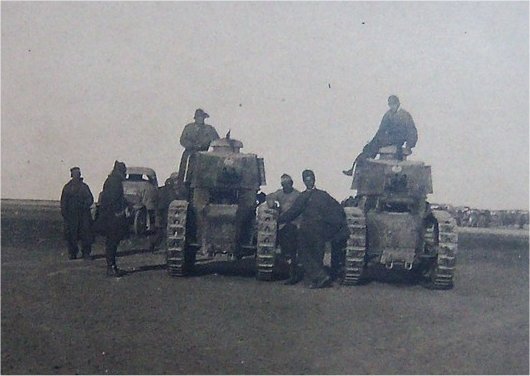
|
|
The 2 FIAT 3000s in the Ronchetti column headed to Giarabub, Lybia, 1926
|
A number of FIAT 3000s took part in the second Italo-Ethiopian war in 1936, when they met the FIAT 3000s which were sold earlier to the Ethiopian government, but no duels between them took place since the Ethiopian FIAT 3000s never had any MG fitted.
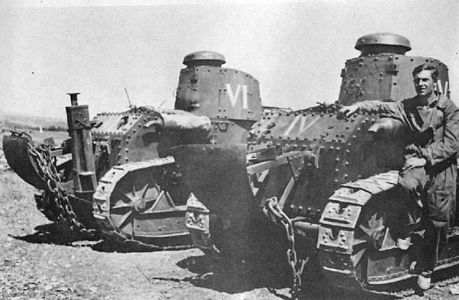
|
|
Two FIAT 3000s in Makall่, Ethiopia, 1937
|
Beside the Italian Army, some FIAT 3000s were sold to Albania, Denmark, Greece, Latvia, Lithuania, Hungary, Spain, Argentina, Japan and Ethiopia. It is possible that Latvian tanks took part in the war against Poland in 1939, because they were certainly seized by the Red Army who might have used them during the occupation of Poland in September 1939; it is also possible that the Red Army used them in the other post-1939 conflicts. Japanese FIAT 3000s took part in the Sino-Japanese War in 1937 and possibly in the Soviet-Japanese War of 1939.
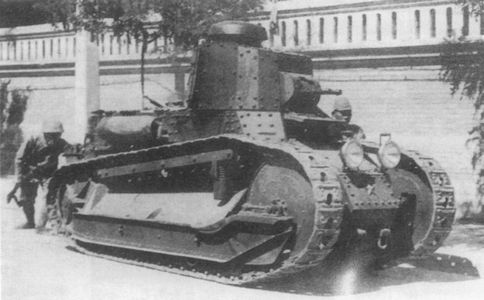
|
|
Japanese FIAT 3000 mod. 30 re-armed with FIAT 29 machine guns.
|
At the outbreak of WW2, the FIAT 3000 was totally obsolete, yet a number of them was assigned to frontier duties, and some of them took part somehow in the short Italo-French war in 1940 and in the Balkan war, 1941.
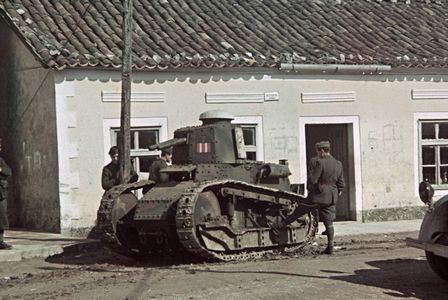
|
|
An exceptional real-color photo of a FIAT 3000 with the 1935 modifications in the Balkans, 1941
|
At the beginning of 1943 some at least 18 FIAT 3000 were reactivated and handed over to two new tank companies the so called 1st and 2nd "Compagnia Carri Armati Fiat 3000" (Fiat 3000 Tank Company) for the defence of Sicily. After much cannibalisation and improvisation always a strong Italian tradition , the two small units were kept ready. Very few of them were encountered by the Allies during the invasion of Sicily in July 1943, one company of them was dug in as pillboxes, while other tanks were attached to Mobile Group "E". Both of these units could not fight allied tanks on equal terms and lost large amounts of equipment. Those Fiat 3000s which had not been destroyed in action were captured by the Americans. The last Fiat 3000 tanks were dumped among the other various AFVs which rested in the depots. No one of these found their way into the Panzerwaffe after the Italian surrender in the September of 1943. The basic chassis could not be upgunned or uparmoured, so gradually they went for scrap, but unfortunately not even one vehicle had been put aside as a museum piece.
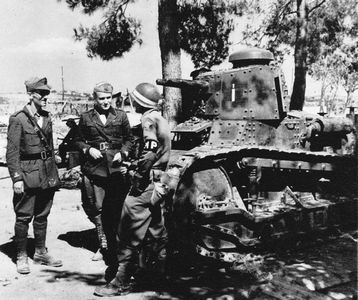
|
|
A Fiat 3000 waiting for the shipment to the USA, Sicily, summer of 1943. The American units claimed some tanks at least two or three as war trophies. (US Army)
|
|
|
Camouflage and markings
As the Fiat 3000s served in so many units and for many years, the different colour schemes in which vehicles were finished were numerous. It is, therefore, obviously impossible to cover the subject fully, but a considerable amount of information was gathered from some photos never published before.
One of the first
camouflage schemes for the Model 21 tanks was an uncommon type, with many
uneven blotches in green (FS 14036) and brown (FS 30176) some with edges
in the other colours which covers almost all the yellow ochre base (FS
33696). Soon
this scheme was substituted by a "waves" camouflage of two colours, painted
at the factory in various patterns, sometimes with vertical stripes on
the hull and horizontal for the turret. It was a rather simple disruptive
design with a high tonal contrast.
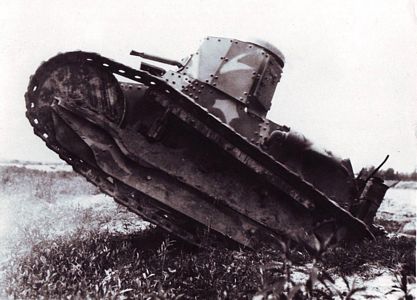
|
|
A mod. 21 version
One of the first camouflage schemes for the Model 21 tanks, during a manoeuvre. The camouflage is an uncommon type, with colours which cover almost all the yellow ochre colour. (Riccio) |
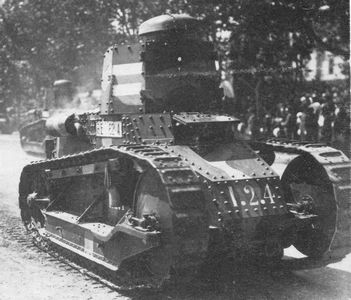
| |
Another mod. 21
A tank with the standard camouflage, ochre base colour with many uneven blotches in green and brown, but with vertical stripes on the hull and horizontal stripes on the turret. Markings and identification code numbers here painted on the hull sides were white.
|
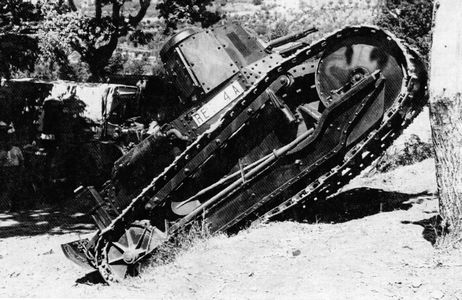
| |
Another mod. 21
On some few tanks, the same camouflage paints, but sprayed, were applied. The markings are "hollow" type for a low visibility. (ANCI)
|
The scheme was not very long lived and was replaced by the more prosaic coat of red brown (FS 30109) in the mid-Thirties. This was a dark brick red brown, nearly a chocolate brown when freshly applied and which could fade to a pinkish shade over time. Photos provide sufficient evidence that for some years new camouflage patterns were applied from 1935, they also reveal that there were two or more designs. The red brown base can be mottled or spotted with dark green (FS 14036), the pattern seems to vary enough, to follow the individual painter's whim, with green blotches or spots painted or sprayed, more or less shaded. A rare camouflage, linked with one last batch of Model 30 tanks, with many small green (FS 14036) and brown (FS 30152) blotches over the base colour, again red brown. In winter, very few tanks showed a white washed surface, with base camouflage showing through here and there, usually markings were painted around.
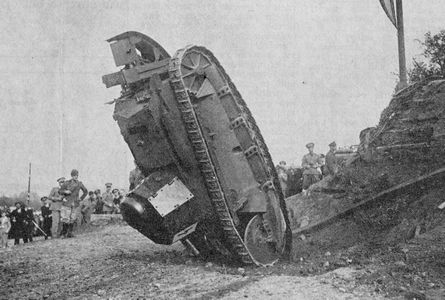
|
|
A mod. 30 version
Unhappy model 30 tank with protection skirts and camouflage only
in red brown, probably not freshly painted. The turret contest number
was black on white paper. |
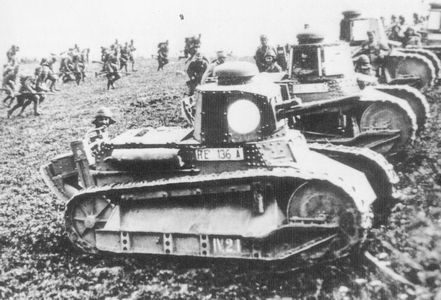
| |
A mod. 30 with gun
A Blue Party gun-tank shows the ordinary red brown camouflage and the old style of markings with code number.
|
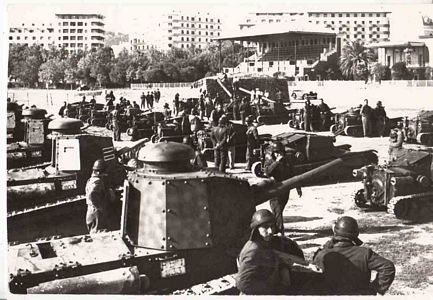
| |
Different mod. 30s
The last know camouflage prior to the adoption of the new grey-green scheme was small dark green blotches on the red brown. The number plate was the new square type.
|
After 1937 the tanks started to be painted in the new dark grey-green (FS 34062), in common with most armoured equipment at this time. This medium green colour with a distinct grey tone has a semi-gloss finish when painted but soon can deteriorate to a matt and faded condition. In June 1940, the Fiat 3000 tanks in service were painted either grey-green or red brown; it appears that some tanks had very shaded grey-green sprayed on the red brown or retained their old camouflage of red brown and dark green. The Frontier Guard tanks kept the camouflage and markings of the other tank units, therefore grey-green with few differences.
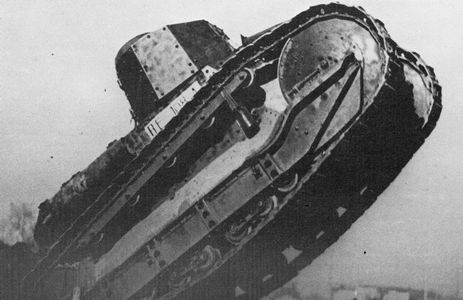
|
|
A mod. 30 version
Late camouflage of few Model 30 tanks, with many small brown and dark green blotches on the normal red brown base coat. The number plate was again the old oblong type. |
New units in
the Army emphasized the need for tactical marking, so the Regio Esercito
extended the practice to Fiat 3000 tanks between 1925 and 1926. Some
tactical symbols were introduced a series of colour coded full geometric
figures painted in four positions on Model 21 and Model 30 tanks and
only three for the Model 30 gun-tanks. The two squadrons (later companies)
in a battalion were denoted by red for the 1st and white for the 2nd.
Company commander's tanks had a circle, while the platoon commander's
tank a triangle, pointed upward for the 1st Company and downwards for
the 2nd. Within the platoon, the tanks were distinguished by a series
of stripes one to three , horizontals for the 1st and vertical for
the 2nd. Tactical signs were accompanied by a code number, painted in
the company colour on the bottom of side frames or rarely side hull
plates, and on the bow. First was a Roman numeral (for the battalion)
followed by two Arabic numbers, for platoon and individual tanks, between
the numbers were two separation points. The style could be slightly
different from the prescribed, without full stops for example. Any tank
could be quickly identified, but this method was of great help to the
enemy intelligence, so towards the middle of the Thirties the code numbers
were usually omitted. Shortly before the start of the Italian attack
against Ethiopia, the new "hollow" markings were adopted which imitated
the previous ones but with the outline only, for lowering their visibility;
however, the bold edges sometime were again too visible. Nevertheless
some older tanks still carried these markings as late as 1939, though
by this time these were not very often seen. To complicate further the
matter, from 1937 the standard camouflage colour for tanks became the
grey-green and markings changed again in the typical "rectangular" system
which remained in use for every Italian tank until the armistice of
September 1943.
All the Italian AFVs had a pressed metal number plate; the Fiat 3000 tank initially had a rectangular type, 58 x 13 cm, riveted and fastened by brackets on the right side of the hull. The background was white enamel, with red "Ro To" (the abbreviation stood for Regio Esercito, Royal Army) followed by black numbers and by a block letter A in red. All the lines weres 10 cm high, and the numbers ran from 1 to 51 and from 53 to 109 for Model 21 tanks, and from 108 to 154 for Model 30. We have no official listing, but known samples of Model 30 gun-tanks numbers ran from 126 to 149. The second and last type of number plate was adopted from 1934, a square, roughly 23 x 15 cm, also riveted to the right side of the hull, just below the turret. Minor differences were in the new red flaming grenade, while the letter A was absent; the numbers remained in the bottom row. The Model 21 registration numbers run from 1001 to 1120, while those for the Model 30 from 1111 to 1154, gun-tanks numbers from 1128 to 1151. Some exceptions can be found in at least two tanks numbered 2599 and 2750.
Depending on the timeframe, a set of three metal badges were present in different arrangements on the Fiat 3000 tanks. First was the Fiat logo (the company builder of the tanks), applied on a small oval and natural metal plaque; with the passing of years, sometimes it was repainted in the base colour of the tank and sometimes it acted as a backplate for a welded Tank Corps badge. Another badge was common to all the military vehicles of the "Regio Esercito": after the brief appearance of a paper badge, from March 1936 a metal badge was adopted. This embossed, circular, bronze cast plate (12.4 cm diameter) was riveted to a backplate. The badge shows the fasces, a five pointed star and the abbreviation "Ro To". A third non-regulation badge was widely applied as a sign of esprit de corps. In fact, it was no more than their crest, a pretty bronze casting 12.5 x 17 cm, welded to the tank turret in different positions during the long service of the Fiat 3000.
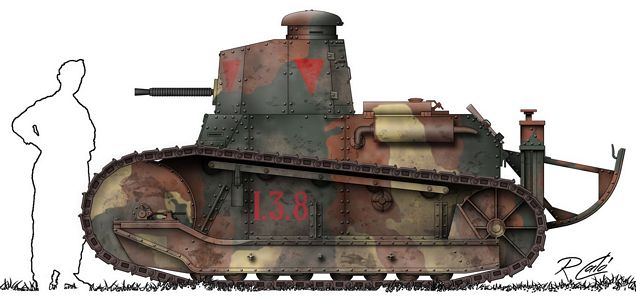
|
|
Model 21 tank (SIA machine guns), 3rd Company, I Tank Battalion, Rome 1927
The three camouflage colours was of French derivation, a base yellow ochre FS 33696 with blotches in green FS 14036 and brown FS 30176. The markings are standard for the time, orange colour triangles for the 2nd platoon, 3rd Company (drawing by Ruggero Cal๒, with kind permission). |
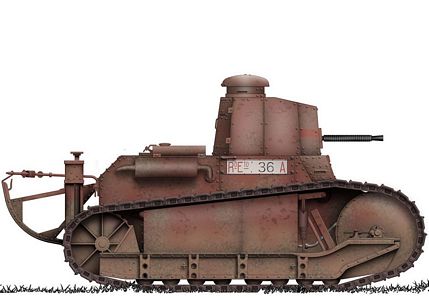
| |
Model 21, "Smoke screen tank" , unknow unit, circa 1931
One of the few examples with the smoke- screen device mounted outside the hull. This tank has been repainted with only a red brown base colour FS 30109 over the previous camouflage. The number plate was of first oblong type (drawing by Ruggero Cal๒, with kind permission).
|
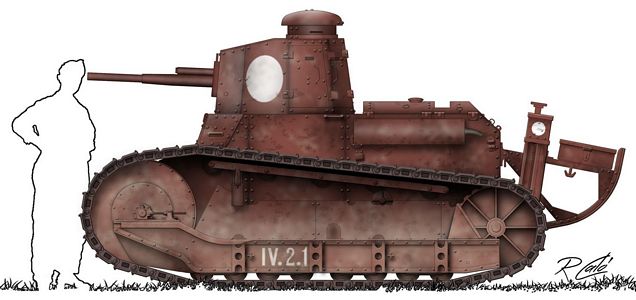
| |
Model 30 c, 2 nd Company, IV Tank Battalion, Blue Party Division, Irpinia manoeuvres of August of 1933
Standard camouflage for this gun-equipped tank, a coat of red brown
FS 30109. The markings was regular for a Company commander tank.
This tank shows a very rare example of marking repeated on the rear
mounted jack (drawing by Ruggero Cal๒, with kind permission).
|
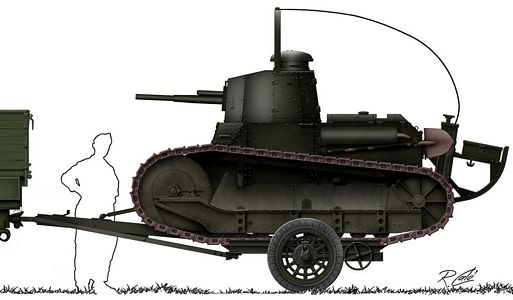
| |
Model 30 c, radio tank, unknow unit, circa 1938
Wireless set was introduced much later and with very few exceptions only on the Model 30 gun tank version. Camouflage was the late type grey- green FS 34062 and the tank trailer was of all metal construction (drawing by Ruggero Cal๒, with kind permission).
|
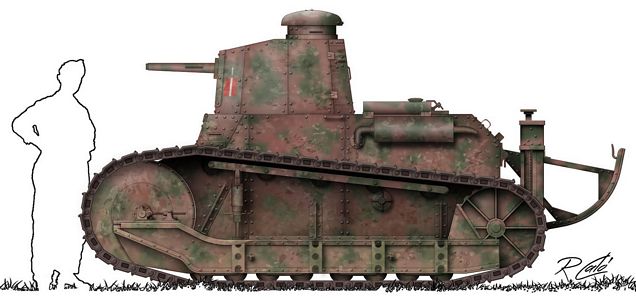
| |
Model 21 tank, 2 nd 'Fiat 3000 tank Company', Biscari airport, Sicily, July 1943
The last Fiat 3000s tanks in service was painted with the ordinary post -1935 camouflage, dark green spots FS 14036 on the red brown FS 30109 base. The tactical markings was red instead of the prescribed light blue. This tank was captured without damages by an American unit (drawing by Ruggero Cal๒, with kind permission).
|
References
[1] Carro FIAT 3000 - Sviluppo, tecnica, impiego, Andrea Tallillo, Antonio Tallillo, Daniele Guglielmi, Gruppo Modellistico Trentino di studio e ricerca storica, Italy 2018 (upcoming)
[2] Fronte Terra - Carri armati in servizio fra le due guerre, vol. 1, Edizioni Bizzarri, Rome, 1972
|

